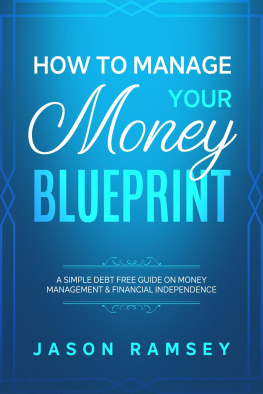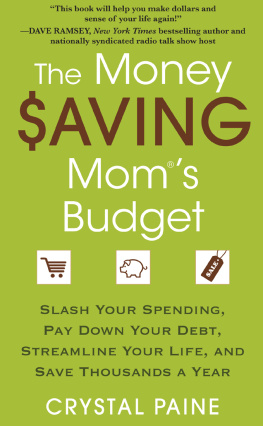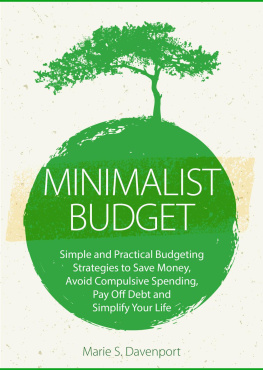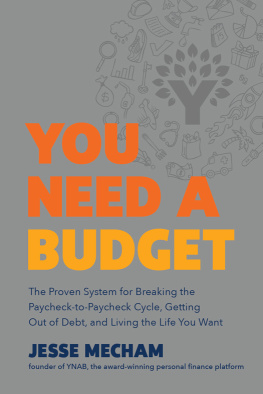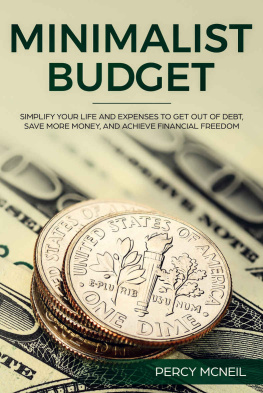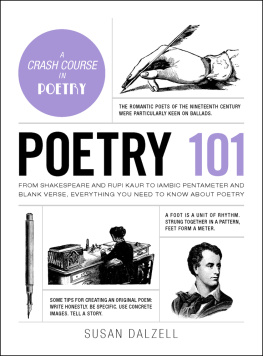This book is dedicated to my husband, Wayne, and my three gorgeous children, Allan, Thomas and Hannah, for making saving money easy. Without them I would never have had a reason to make the change from Spendthrift to Cheapskate, and the Cheapskates Club would never have existed. Thank you for putting up with the thousands of experiments over the years; some of them edible, some of them not, some of them successful and some of them, well, not. And thank you for putting up with my wacky ideas, and not laughing too much at me when I tried them. And thank you most of all for understanding that they were all done in the name of loveand money-, time- and energy-saving research. I love you all.
CONTENTS
I havent always been a Cheapskate. Circumstancesand a desire to not live in a tent for the rest of my lifeforced a change in my attitude to money.
Not so very long ago, I was a very happy and contented wife and mother to two small boys, working part-time and helping my husband renovate our house.
Then Disaster Struck. Within the space of five days we went from a two-income family of four to a no-income family of four with one on the way. To say I was stunned is an understatement.
We had the same living expenses as everyone else we knew and we lived a very good life. It came as a shock to me to realise that when the money in the bank ran out, that was itwe would be broke. Not just poor, but broke, with not a cent to our names. Not only would we not be able to maintain our standard of living, but we would most likely not even be able to live.
I liked our life and I certainly didnt want to change the way we lived so I had to find a way to maintain our lifestyle and standard of living on a drastically reduced income.
It wasnt easy at first. I had to learn to cook from scratch. Yes, I could grill a steak and toss a salad, and I could prepare a pretty good four-course formal sit-down dinner for 12. But when it came to baking, bottling and preserving, I knew almost nothing.
I had to learn to sew properly. Years of sewing classes in high school had given me nothing but a dislike of fabric, needle and thread. I learned to sew so I could dress my children and myself fashionably without spending even bargain-basement prices.
I learned to grow our own food. Until Disaster Struck, gardening, to me, was pots of pretty petunias on the verandah and borders of chrysanthemums along the fence. These days, the pots have garlic and parsley in them and the borders are cauliflowers and peas and celery and tomatoes and other yummy things.
I have been blessed with a mother who loves to cook and sew and knit and garden and even clean. Mum can give instructions on how to set in a sleeve over the phone and not think twice about it. My three favourite aunts are all talented cooks and homemakers and bargain hunters who have never been afraid to share their knowledge with me. My mother-in-law can stretch a dollar until it screams and do it with a smile on her face, and she too has shared secrets to frugal living with me.
I will admit to having always loved a bargain. My friend Deirdre used to say I was the only person she knew who could see a Sale sign two blocks away. I remember being taken to factory sales (back in the days when they were really at the factory) and waiting in line for what seemed like hours so Mum could pick up a few bargains. Each winter I still wear a coat that I picked up from an outlet sale for $50 when it was $300 in the shops.
But I havent always been a Cheapskate: living the Cheapskates way developed over time. It wasnt an overnight transformation (although we would have been so much better off if it had been) but a gradual thing. We didnt make any huge changes, but lots of small individual adjustments that added up to thousands of dollars saved every year.
Some of the changes didnt quite work the way I thought they would. Making my own paper was a disaster from the beginningit cost more in materials and time than I ever would have saved. And I have served some memorable dinners (one particularly awful salmon dish springs to mind) in attempts to save some money.
I dont believe in living miserably and going without things we need or want just to save money. I dont believe in saving money just to die with a huge bank balance. I do believe in not spending money on things that arent important to us so we have the money to spend on the things that are.
These days money isnt so tight, but our budget still is: we havent changed it much since we began this journey. Expenses have increased in some areas and decreased in others. I have become better at finding bargains or making what we want. We have more to share than ever before.
And life is good.
I used to think nothing of eating lunch out a couple of times a week, meeting friends for coffee every morning and buying the kids a treat each time we went out. We lived well, but we had little in the bank and no Emergency Fund or Peace of Mind Account, so when Disaster Struck, our vision for the future changed. Drastically.
We had never had a written Spending Plan before, so we sat down with an exercise book and pen and worked one out.
Your Spending Plan can stretch your familys finances and help you live life debt free, cashed up and laughing. A Spending Plan helps you see how to use the money you have to pay bills and get more of the things you need and want. It lets you decide what is important to your family and make choices before spending your money.
Getting into the routine of your Spending Plan will give you control of your money. You can see at a glance how much comes in and when, and how much goes out and when. Your Spending Plan will be working for you, giving you peace of mind and leading you towards that light at the end of the tunnel.
For beginner budgeters, using a spreadsheetor even a ledgerto develop a Spending Plan can seem overwhelming and way too hard. An easy way to create a Spending Plan and keep it updated is to use the envelope system. This was developed back in the olden days, before PCs and spreadsheets, but it still works today and is just as efficient a method of budgeting as a computerised program.
The instructions below are for working out a monthly Spending Plan. If you prefer to use a fortnightly or weekly Spending Plan, adjust the amounts accordingly: for a fortnightly Spending Plan, divide the total by 26 and for weekly, divide by 52.
To get started you will need:
a box of plain envelopes
pens
a calculator
as many receipts and invoices from the last 12 months as you can find
pay slips for the past 12 months
bank statements for the past 12 months
Step 1: First you are going to work out how much you need to put aside for all your fixed bills. Gather all your regular bills (gas, electricity, phone, Internet, insurances, car registration, rates, mortgage, school fees, bus fares etc) for the last year so you can work out how much you need to cover these regular expenses. For a monthly Spending Plan, add all the amounts for each bill for the year and divide the total by 12 to give you a monthly total. This is how much you need to be putting aside each month to cover the bill when it comes in.
For us, a family of five, with three members being teenagers, we need to put aside $1084 a month to cover these expenses. Each month this amount is automatically transferred to our Living Account.
Step 2: Now you can work out how much you need to cover other flexible expenses (petrol, food, clothing, medical, chemist, birthdays, Christmas, holidays, hobbies, club memberships etc). Calculate the amount you need to put aside the same way you did for your fixed expenses.
Next page


